“The true test of democracy is in its ability to ensure creation and protection of spaces, where every individual can voice their opinion, without the fear of retribution.”
-Justice D.Y. Chandrachud
The menace of FAKE NEWS which led to lynching of two youth in Assam in 2018 has crept its way in our fight against SARS Covid-19.
To deal with it Mumbai administration on 23rd May 2020, under section 144 of Criminal Procedure Code (CrPC) passed an order to curb the spread of fake news. However, a bare reading of the order implies prohibition of all kinds of information. The order prohibits dissemination of information through various messaging and social media platforms, which are found to be-
- “incorrect and distorted”
- “derogatory and discriminatory towards a particular community”
- “causing panic and confusion among the general public
- “or inciting mistrust towards government functionaries and their action taken to prevent the spread of the disease.”
It also makes administrators of groups on messaging and social media platforms personally liable for such violations.
Section 144 of crpc enables an executive magistrate to pass an order restricting either an individual or general public to abstain from doing something or to do something with the property which is in his/her possession.
Sectioin 144 is used by administration when there is any apprehension
of danger such as obstruction, annoyance or injury to any person or danger to human life, health and safety or disturbance of public tranquillity including riots and affray.
It is due to its vague and ill-defined terminology that it was regarded as a “Gag Order” i.e. an order/directive which prevents public disclosure of information on a particular matter.

The order in effect prohibits criticizing the state government where it is failing in containing the spread of the coronavirus. This order has been criticised primarily for restricting “freedom of speech and expression” granted under article 19(1)(a) and as an attempt to curb dissent against the state government.
Although the intention of the order is justified, it is the order’s vaguely used terms and the scope which in effect curbs free speech and legitimate criticism.
Restrictions not reasonable
The Indian Constitution provides every citizen, freedom of speech and expression under article 19(1) (a) and the restriction on the said article, can only be imposed on grounds mentioned in Article 19(2) only, which includes
“sovereignty and integrity of India, security of state, public order, decency or morality or in relation to contempt of court, defamation or incitement to an offence”.
It must be noted that the restriction on these grounds needs to be “reasonable restrictions”.
In Chintaman Rao v. State of M.P (AIR 118, 1950 SCR 759) apex court said that reasonable restriction means a limitation must not be arbitrary or excessive in nature. The order has the potential to make slightest of criticism or news piece contrary to governments take on the disease as punishable The scope of speech which is restricted by the order includes legitimate dissent, thus the order is arbitrary and no intelligent care was given for deciding on a “least restrictive measure”, as stated in Anuradha Bhasin v. Union of India (2020). It this case courts ruled that drastic measures like complete suspension of telecom services must be considered by the states only if it is necessary and unavoidable and the state must assess the existence of an alternate less intrusive remedy. This is because a right if restricted must conform to the concept of Due-Procedure. Thus before passing such a vague order intelligent deliberations should have been given as to whether the objective of fake news could be curbed by taking curse to an alternative remedy, which would have been less restrictive.
Least restrictive measure/less intrusive measure test in Anuradha Bhashin case:
Least restrictive measure principle was considered by the Supreme Court in Anuradha Bhasin case. It means that if a public interest can be achieved by imposing a less drastic restriction on fundamental rights, then such less drastic restrictions must be employed by the state to achieve the objective, so as to conform to proportionality doctrine, that is to say, that state must prefer “an equally effective but lesser restrictive alternative remedy”. (Anuradha Bhasin case)
“In determining proportionality, the court will have regard to whether a less intrusive measure could have been adopted consistent with the object of the law and whether the impact of the encroachment on a fundamental right is disproportionate to the benefit which is likely to ensue”.-Justice K.S.Puttaswamy (Retired). vs Union of India And Ors.(2017).
Less restrictive restriction principle is used by constitutional courts to determine the reasonability of a restriction. If the restriction has a disproportionate impact on fundamental rights or an equally effective but less restrictive remedy existed, then it may declare restrictions imposed as invalid.
Test of least restrictive measure is part of a four-pronged test devised by German Constitutional Courts to determine the proportionality of a restriction on rights.
Order overly broad
According to Doctrine of Over-breadth, a law is declared substantially overbroad when because of its vague language, it proscribes (prevents) not only speech that needs to be prevented but also speech that is constitutionally protected (like legitimate criticism). The order provided no guidance on what constitutes distorted facts, this in effect leads to curbing freedom of press and would also penalize legitimate criticism of the state government. The order inadvertently restricts freedom of speech and opinion against the state administration.
The doctrine of over-breadth was used by the Supreme Court in Shreya Singhal v. Union of India (2015) in which wording of section 66A of Information and Technology Act, 2002 was so vague that it virtually penalized any dissenting opinion against the government, through online media. Because the restrictions were so vague, it made the law overly broad, and this resulted in the restriction of speech that was constitutionally protected. Justice D.Y. Chandrachud said, “Dissent is the safety valve of democracy”.
Administrative discretion
Anything against the administration could be categorised as “mistrust towards government functionaries and their action taken to prevent the spread of the disease. “The order leaves it completely on the discretion of the administration to decide what facts are incorrect and distorted. Uncertain nature of coronavirus and lack of study on it has led to varied study on it. A study which might not be favourable to the administration could be regarded as distorted. This results in penalising even legitimate criticism. In Kartar Singh v. State of Punjab apex court had observed that “a penalizing provision should give a person of ordinary intelligence a reasonable opportunity to know what is prohibited”. This level of administrative discretion has potential of being regarded as Colourable exercise of power, which means that under the colour or guise of power conferred for one purpose, the authority is seeking to achieve something else which it is not authorized to do so or could not do so, der the law, e.g. power of preventive detention as a substitute for criminal prosecution.
Administrative discretion on deciding what should be penalised under the order not only makes the order overly broad by restricting free speech but also Freedom of Press. Lack of definition of what amounts to creating mistrust, causing panic and confusion among the general public coupled with administrative discretion has the potential to prohibit bonafide reporting of government’s action as well as inaction.
Way Forward
The pandemic has led to governments around the world to resort to drastic measures, it is the responsibility of the administration to ensure that no feeling of anxiety or uneasiness is spread. It must be noted that the falsehood and fallacies of something can only be exposed by more speech and not enforced silence. Rather than restricting communication, the objective should be to establish a mechanism where people can fact check a piece of information. This will not only be useful during such testing times but also to counter fake news in other areas. A dedicated helpline or online portal should be set-up where people can ask questions and verify information on Covid-19. Dedicated machinery needs to be set up for identification and verification of such information.
Such a set-up would help nip fake news in the bud and would help to deal with this menace even after the pandemic.
Media in this case of extremely useful in pinpointing fake news thus rather than enforcing silence, the object should be to work in conjunction with them, rather than to suppress them.
Disclaimer: The views and opinion expressed in this article are those of the authors and do not necessarily reflect the views of ‘thelawmatics’.
Author: Aksshay Sharma,Department of Laws, Panjab University Chandigarh

Thanks for giving a simple definition of doctrine of overbreadth
Your welcome 🙂
Like!! I blog frequently and I really thank you for your content. The article has truly peaked my interest.
I like the valuable information you provide in your articles.
I like this website very much, Its a very nice office to read and incur information.
Very good article! We are linking to this particularly great content on our site. Keep up the great writing.